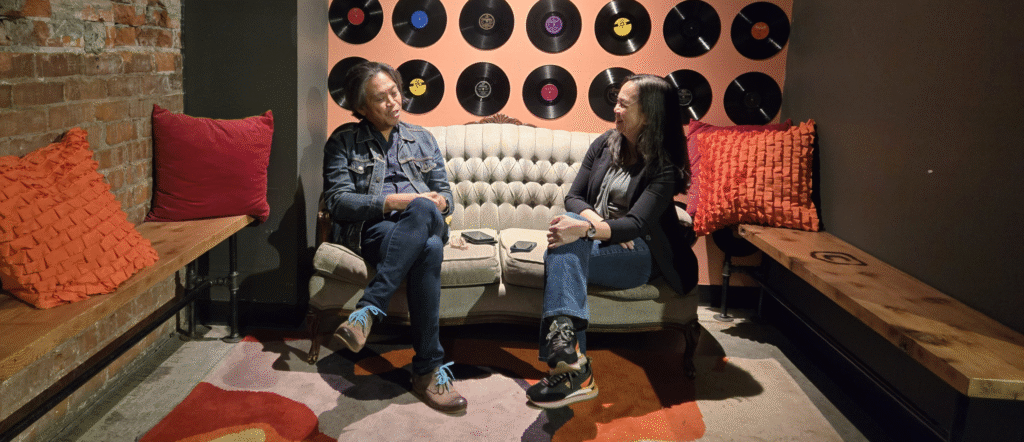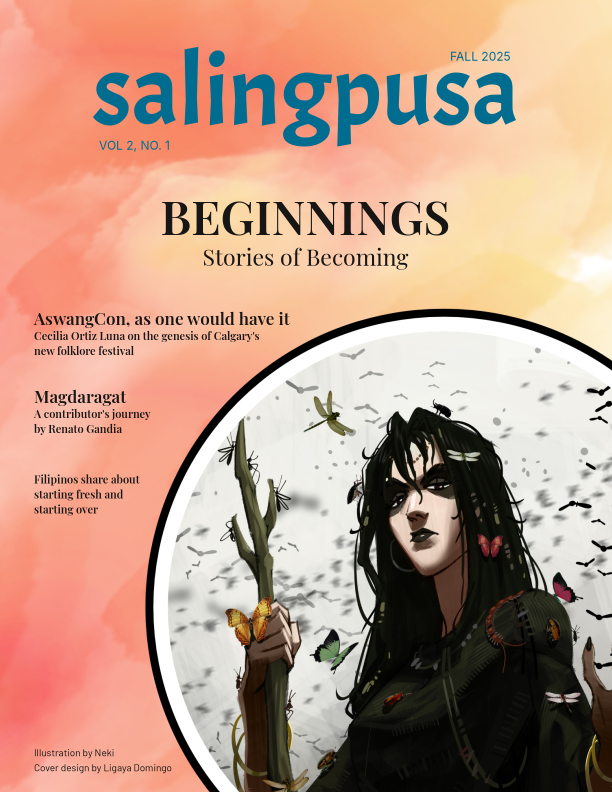
Salingpusa’s New Beginnings
By Cecilia Ortiz Luna
Renato and I met eight months ago at a poetry workshop where we both served as panelists. I have a modus operandi when attending events like these. As Executive Director of Salingpusa Creatives, I was always on the look out for Filipino artists to invite into the fold and was mercenary in my methods.
With Renato, though, I didn’t need to concoct a line. I’d previously read his essay in the anthology Magdaragat, and his piece, for me, stood out in a collection featuring forty-three Filipino authors. It was about childhood trauma, and he wrote the scenes with such vividness that they stayed with me long after I read them. When I introduced myself to Renato, it was as a fan.
This introduction led to correspondences. He attended a grant-writing workshop I facilitated. We had sushi lunch at Kensington. By this time, I felt such awe that the boy with those heart-breaking experiences is now living a wonderful life, in a wonderful city.
We share a number of commonalities: migrated to Canada as adults, slight physiques, Tagalogs, adorers of our supportive husbands. More importantly, we are both writers at that stage in our journey where we are “putting our art out there”.
Like Renato, I consider myself a writer first and foremost. But events in my life for the past year have pulled me aggressively toward community and arts organizing. The magazine has always been the core of Salingpusa’s advocacy efforts, but it had suffered from inattention because of the shift in my activities. I always knew that what the magazine needed was someone with years of writing and editing experience and who matched my passion for the written word. Someone like Renato.
In July, I invited Renato to join me at the helm of Salingpusa Magazine as its managing editor. After a few days, he accepted. I thanked my saints and stars. Immediately, he poured himself into the job and set about putting structure and system into producing a revitalized magazine.
The timing of this edition also coincided with a lot of positive developments in our respective endeavours. I was having a moment in my community work— obtaining a Calgary Arts Development project grant for Salingpusa’s marquee event for 2025, the Aswang Con Folklore Festival and recently being chosen by the Alberta Foundation for the Arts as community connector for Calgary. Renato has three stories accepted by three magazines that are coming out one after the other, with more on the way.
For this first issue in the new era of Salingpusa Magazine, with its theme New Beginnings, I thought it apropos to sit down with Renato at this lovely nook outside our Salingpusa headquarters at the Grand Theatre and talk about our individual projects and the future of Salingpusa Magazine.
(The conversation was edited for brevity.)
Cecilia: Renato, can you tell me about your recent publishing achievements?
Renato: I have a piece coming out in Ginger and Smoke Magazine at the end of October. It is a folklore story about bales I also have a story that will be published by Yay! all queer: Free and Queer. It’s about a trans woman who has not fully transitioned, then mistaken for a man and suspected to be a murderer.
The third story is for the anthology Beyond the Concert Hall by Laberinto Press. This story was narrated from the point-of-view of a 10-year-old girl perplexed at why their house was always quiet. This story explores collective memories of Filipinos during the Second World War.
Cecilia: One thing that I have learned and admire about you is that you are a prolific writer. You write well and you write fast. Have you always been like this?
Renato: I’ve started thinking of myself as a writer while I was in grade six in the Philippines. My teacher always asked me to read what I wrote in front of the class. My classmates then had always thought of me as someone different—a softie. When I read my stories, I felt that I have this power. I thought, you will sit there and listen to what I say, even though in the playground, you think of me as inferior, and you tease me for being gay. That was the impetus, because when I stand there reading my piece, they listened. That continued through high school and college.
When I came to Canada. I didn’t stop writing but I stopped sharing what I was writing. Until recently.
Cecilia: For every writing assignment I throw at you, you always come back with an excellent piece, be it Tagalog or English. Even on a time crunch, you seem to always operate at a high level.
Renato: Part of it is being a BIPOC writer. I didn’t always write in English. My medium was Tagalog. (Renato previously self published a collection of short stories in Tagalog, titled Kapirasong Pagkabagabag sa Nalilitong Magdamag). I started to write in English in Canada. I’ve always challenged myself. I needed to be better at everything I do and what I write. If I can be good from the beginning of the process (of writing), if it is of a quality I am willing to share outside my writing dungeon, then I will feel secure. I’m a very insecure writer, actually.
Cecilia: What are you envisioning for Salingpusa magazine?
Renato: For the Filipino voice to be heard, the Filipino word to be read— by Calgarians, by Albertans, by everyone who has access to internet. I want them to see and to witness that there’s a lot of artists in this beautiful city, and some of them are Filipinos. A lot of Filipino artists have stories that need to be told, need to be heard. I think the magazine would be able to provide that locus for this creation of art to happen. For this creation of voice to spring from.
I would like to encourage the Filipinos out there who are shy about writing. By helping this magazine, I want to reach out to those people by encouraging them to be part of the creative community here in Calgary.
Renato: Cecilia, what’s inspiring you to organize? To keep going with this?
Cecilia: By “this”, I know you mean the often back breaking and uncompensated work of coming up with arts events and marshalling people to participate in them.
I’m very much a late bloomer in both the writing and arts organizing scene. Growing up in the Philippines, I was into all activities that at that time, I didn’t consciously consider as Art. I was into dancing, singing, drawing and writing, and I was good at all these things.
There were two things that I would have loved to have done when I was young. The first was to study at the Philippine High School for the Arts in Laguna where I will be surrounded night and day by fellow creatives. The second was joining the Bayanihan Dance Troupe and travel around the world dancing the magnificent singkil. But my parents, understandably, prioritized academic achievement over everything else.
I was already in my 50’s when I decided to pivot to this fully creative life and it was only thanks to the serendipity of this major shake-up in my life (a story for another day). So I suppose this is me trying to make up for having missed that chance at living the artist life and interacting on a regular basis with fellow artists.
The other answer is that it has to be done—the work of teasing out these talented Filipinos out there from their shells and presenting their works, their voices to the public. And I feel able to do that work, and to do that work well, so why not?
Renato: What are your dreams for Salingpusa Magazine?
Cecilia: For the magazine to be a vehicle for the Filipino collective story to be heard, appreciated and learned from. For the members of the Filipino diasporic community in Calgary/Canada to see themselves in this collective story. For individual Filipino storytellers to have a space where their writing dreams will be actualized in some way.
You and I, we both know the feeling when someone expresses that they connect with your writing. The validation that comes from that is the best feeling. I want to bring that experience to these writers, through the magazine.
The dream? The dream is for Salingpusa Magazine to be known as one of, if not the magazine Calgarians, and Albertans turn to for good quality Filipino writing.
Renato: Putting together a magazine is not an easy project, there are a lot of challenges. Tell me something about the first issue of Salingpusa Magazine.
Cecilia: The first issue was really challenging. We were putting it together when I had an incomplete vision of what and who the magazine was for. The early drafts of the first magazine was a case of lakas-ng-loob (or rather, kapal ng mukha) exceeding editorial prudence. It was a mish-mash of stuff that, if not for my daughter Arianna’s superior developmental editing skills, would have turned into, at best, a mediocre issue.
But, if I may say so myself, it was a triumph in its own way. Members of the Filipino community responded to it with nothing but glee and positivity. They recognized that Salingpusa Magazine was a community thing, that it was about them and for them. That is what I want to preserve and use as inspiration in continuing with this project.
Renato: For my final question: we are relaunching the magazine with this new issue. It’s a new beginning, which is the theme that we packaged for the magazine. How do you feel about that?
Cecilia: It is indeed a new beginning, a fresh start. We both have big dreams for this magazine and I feel sure that we will achieve those dreams, just going by how we’ve managed to get to where we are now. Baby steps in the greater scheme of things, for sure, but I feel we are headed in the right direction. I am super excited and feel very optimistic for Salingpusa Magazine’s future.




